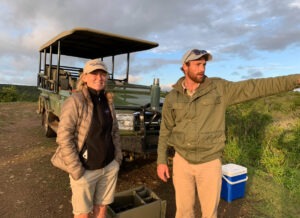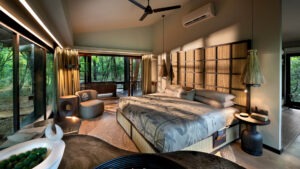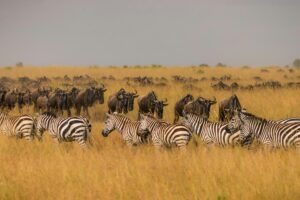Planning your first safari
Planning your first safari is an exciting adventure, but it can also feel overwhelming—believe me, I’ve been there.
When I was preparing for my first safari, I had no idea what to expect. I thought I’d be hopping into a jeep sometime in the morning and driving around all day looking for animals, but as you’ll discover below, that’s far from reality!
Luckily, my first safari was a huge success, and since then, I’ve been on 10 more trips and planned countless safaris for my clients. Now, I want to help you avoid the confusion I felt and make sure your safari is a trip of a lifetime.
In this guide, I’ll walk you through everything you need to know—where to go, when to go, where to stay, and what a typical safari day looks like. By the end, you’ll feel confident and ready to book the perfect safari, tailored just for you.

What to Consider
Planning your first safari can feel a little overwhelming, but don’t worry—I’ve been there! Here are the key things to keep in mind to help narrow down your choices:
What’s your budget?
Safaris can vary greatly in cost depending on where you go, what you want to see, and where you stay. Think about your budget early on, but don’t pull a number out of thin air.
Take a look at some lodges you like the look of to get a sense of the range. Generally, prices are per person, per night, and usually include all meals, two daily game drives, and often drinks.
Safaris can start from around £100 per night and rise to £1,000 or more for ultra-luxury lodges.
Knowing what’s included can help you make a smart choice for your budget.
For instance, if you’re looking for something luxurious, Chitwa Chitwa in Sabi Sands offers private game drives, gourmet dining, and exceptional accommodations.
If you’re after more affordable options, Mohlabetsi Safari Lodge in the Greater Kruger Park offers excellent value for money while still delivering incredible wildlife experiences.
What do you want to see?
Have you always dreamed of spotting the Big Five (lions, leopards, rhinos, elephants, and buffaloes)?
Or perhaps you’re after something a bit more specific, like cheetahs, known for their love of open grasslands and plains where they can use their speed to hunt?
In contrast, leopards prefer tree-dense areas, using the trees for cover, to stalk prey and as a safe place to rest or store their kills.
If you’re a bird lover, you might want to visit somewhere like Lake Bogoria in Kenya’s Rift Valley, where you can see thousands of flamingos turn the lakeshores pink, alongside other bird species like pelicans and kingfishers.
Different safari locations excel at showcasing different animals, so knowing what’s at the top of your wildlife wishlist will help narrow down your destination.
How do you like to travel?
Do you picture yourself in the height of luxury, or are you looking for something more mid-range and rustic? There are lots of options: from luxury lodges with private game drives and spa treatments to cozy tented camps that bring you closer to nature.
For example, &Beyond Ngala Tented Camp offers a chic, intimate experience with luxurious tented suites, while still maintaining that sense of being immersed in the wilderness.
On the other hand, Jock Safari Lodge in the Kruger National Park provides an authentic, charming experience with colonial touches.
Think about whether you’d prefer amenities like pools and gourmet dining or a simpler, more back-to-basics wilderness experience.
It’s all about what feels right for you.
What about malaria precautions?
If you’re concerned about malaria, especially if you’re taking your children, there are plenty of malaria-free and low malaria-risk safari options across Africa, especially in South Africa (like Addo Elephant Park, Madikwe Game Reserve, and Pilanesberg National Park).
Alternatively, you can take precautions like anti-malaria medication if you’re traveling to areas where malaria is present.
Also, be sure to check vaccination requirements for your destination, as some regions may require specific vaccines. Planning ahead will ensure that your safari is not only memorable but safe.
Where to Go: My Top Picks for First-Time Safari-Goers
If you’re planning your first safari, Africa offers an incredible range of destinations, each with its own unique appeal.
For those who’ve read my guide, you’ll already be familiar with the pros and cons of South Africa, Kenya, Tanzania, Zambia, and Botswana.
But whether or not you’ve seen the guide, I want to make it easy by sharing my top recommendations for first-time safari-goers – places that offer both ease of travel and unforgettable experiences:
South Africa
South Africa is an excellent choice for first-time visitors due to its accessibility, with daily direct flights from the UK to Cape Town and Johannesburg, and some of the best infrastructure for safaris.
One of the easiest and most rewarding destinations is Kruger National Park, where you can see the Big Five, cheetahs, giraffes, and the elusive wild dogs, all in a comfortable, well-developed setting.
Alternatively, the Eastern Cape offers a more intimate experience with Shamwari Game Reserve, known for guaranteed Big Five sightings and a visit to the Born Free Big Cat Sanctuary.
I have strong connections with the Born Free Foundation and local conservation teams, so I can even arrange out-of-the-ordinary experiences for you there.
Kenya
Kenya is another fantastic destination for first-time safari-goers, particularly the Masai Mara National Reserve.
This wildlife paradise is home to the Great Migration and abundant wildlife all year round. From hot air balloon safaris to bush walks, you’ll be immersed in the wonders of Africa.
If you’re looking for something different, Amboseli National Park offers breathtaking views of Mount Kilimanjaro and large elephant herds. Or explore the Laikipia Plateau, home to Kenya’s most elegant lodges, offering a more exclusive and remote safari experience.
But if you’ve zeroed in on another destination—like tourist-lite and wilderness-filled Botswana, wild, untamed Zambia, or breathtaking Tanzania, with its combination of iconic parks and pristine beaches — they’re all wonderful too.
Each has its own special magic, whether it’s the untouched wetlands of the Okavango Delta, the thrill of walking safaris in South Luangwa, or the Serengeti’s endless plains.
You can’t go wrong with any of them.
When to Go
The best time for a safari largely depends on where you’re going and what you want to see, but as a general guideline, the following applies:
Dry Season (June – October):
Generally considered the best time for wildlife viewing, as animals congregate around fewer water sources, making them easier to spot.
Expect cooler mornings and evenings, so it’s a good idea to bring layers for early game drives.
During this time, the sparse vegetation also makes it easier to see wildlife from a distance.
Many safari-goers prefer this season for its predictability, clearer skies and prime game viewing.
Wet Season (November – May):
The wet season brings lush, green landscapes and is known as the “secret season” for good reason—it’s when many animals give birth, so you’ll often see adorable newborns alongside their mothers.
However, the lush greenery can make wildlife harder to spot, as the dense foliage offers plenty of places for them to hide.
Be prepared for potentially tricky driving conditions, especially in more remote area, and expect high humidity and hotter temperatures in some regions.
If you’re into birdwatching, though, this is prime time to visit, as many migratory bird species arrive during the rains.
Migration Timing
If witnessing the Great Migration in Kenya or Tanzania is on your bucket list, then plan your trip between July and October when millions of wildebeest and zebras cross into Kenya from Tanzania.
This dramatic spectacle often includes predator action along the way, with lions, crocodiles and hyenas lying in wait.
For a more immersive experience, you can even time your trip to watch a river crossing—a heart-pounding moment as the herds plunge into crocodile-infested waters.
Where to Stay
Your accommodation choice is one of the most exciting parts of planning your safari.
There are various options to fit your preferences, from traditional luxury lodges to adventurous mobile tented camps.

Here’s a breakdown of the different types:
Luxury Lodges
For those seeking the height of comfort, luxury lodges provide an all-inclusive experience with spacious suites, gourmet dining, private game drives and often spa facilities.
Many are architecturally stunning, blending seamlessly into the landscape while offering incredible views of wildlife. These lodges offer not just a place to stay but an immersive luxury experience where every detail is taken care of.
Luxury Tented Camps
Offering the feel of an adventurous safari without sacrificing comfort, luxury tented camps are the perfect blend of elegance and immersion in nature.
These camps are often permanent or semi-permanent structures with canvas walls but include amenities like en-suite bathrooms, plush bedding and sometimes even plunge pools.
They allow you to get closer to the sounds and sights of the bush while still enjoying high-end service.
Mobile Tented Camps
For a more adventurous safari experience, mobile tented camps are ideal. These camps move with the seasons to follow wildlife migrations, offering a more flexible and intimate connection with the environment.
While they may not have the opulence of luxury lodges, mobile camps provide a sense of adventure, often with excellent guides and a close-up feel of the wilderness.
Picture basic but comfortable tents, campfires under the stars, and waking up to the sounds of animals nearby.
These camps are perfect for those who want to experience nature up close while still having essential comforts like good food and comfortable beds.
Game Parks vs. Conservancies
One of the key decisions you’ll make when planning your safari is whether to stay in a national game park or a private conservancy. Here’s how they differ:
Game Parks
National game parks, such as Kruger National Park or Masai Mara National Reserve, are typically larger, more well-known areas that are open to the public.
These parks are managed by governments and offer vast landscapes with incredible wildlife densities.
While game parks provide great wildlife viewing, they can be busier, especially during peak seasons and off-roading to get up close to animals may be restricted.
You’ll likely share sightings with other vehicles, especially at popular attractions.
Conservancies
In contrast, private conservancies, such as Sabi Sands (adjacent to Kruger) or Olare Motorogi in the Masai Mara, are privately managed reserves.
They tend to have fewer vehicles, more personalized service and often allow for unique activities such as night drives or walking safaris.
Conservancies typically restrict the number of guests, giving you a more exclusive and intimate experience.
Conservancy guides often have more flexibility in where they can take you, including the ability to off-road for closer wildlife encounters. Plus, a portion of the fees often goes directly to conservation efforts and supporting local communities.
What to Expect on a Safari Day
When I planned my first safari, I thought I’d spend most of the day driving around looking for animals, not realizing how carefully the days are structured to give you the best wildlife experiences.
I also wasn’t prepared for the early mornings! But after countless safaris, I’ve come to love the rhythm of a typical safari day. Here’s what you can expect:

Morning Game Drive
Be ready for a pre-dawn wakeup call—safaris start early because this is when the animals are most active. You’ll have a hot drink and some biscuits to tide you over before heading out. Even though it’s Africa, mornings can be cool, so layers are a must.
The game drive itself is a thrill—your vehicle will be open-sided and your experienced ranger will guide you to some of the best wildlife sightings.
The early start is well worth it when you find yourself watching lions on the move, elephants feeding, or giraffes silhouetted against the rising sun.
Breakfast
After your morning drive, you’ll return to the lodge for a hearty breakfast. Some lodges even arrange for a bush breakfast in a beautiful outdoor setting—imagine dining by a river as you watch animals in the distance!
In Between Game Drives
The rest of the day is yours until the evening game drive.
Relax by the pool, read a book on your terrace or indulge in a spa treatment.
You can also arrange special excursions, like a walking safari to get a closer look at the smaller details of the bush, or a conservation experience where you can learn about local wildlife efforts.
These quiet hours are a chance to unwind and take in the magic of the African wilderness.
Evening Game Drive
In the late afternoon, after tea and cakes on the lodge terrace, you’ll head out on your second game drive.
As the temperature cools, the animals become more active again. This is often the time when predators, like lions and leopards, begin to hunt.
At sunset, your guide will stop for “sundowners”—an iconic safari tradition where you’ll enjoy drinks and snacks as you watch the sky turn shades of pink and orange. There’s nothing quite like sipping a gin and tonic while hearing the distant roar of a lion.
Dinner
After the drive, you’ll return to camp under a star-filled sky.
Dinner is often served outdoors, and it’s a wonderful way to reflect on the day’s sightings. By the time you head to bed, you’ll be ready for a good night’s sleep before it all starts again the next morning!
What to Wear
When I was planning my first safari, I had no idea what “safari clothes” were really for. I thought people wore them just to look the part—like khaki was some sort of safari fashion statement!
Little did I know, the muted sandy colours you see in all the photos aren’t about style, they’re for blending in with the environment. Wearing the right colours helps you avoid catching the attention of curious wildlife—and trust me, that’s exactly what you want!
Here are a few things I’ve learned (the hard way) about what to pack.
Avoid Bright Colours
Leave the neon tops and bold prints at home. Bright colours stand out in the bush, and while they may be great for beach holidays, they’re not ideal for blending in on a game drive.
Stick to neutral tones like khaki, beige and olive green. This will help you avoid attracting unwanted attention from the wildlife.
Comfortable Shoes Over High Heels
I’ve seen it happen—people bringing heels to a safari!
Safaris are all about comfort and practicality, so opt for sturdy walking shoes or hiking boots. You’ll be climbing in and out of 4×4 vehicles and possibly walking on uneven terrain during a walking safari, so you’ll want something that gives you stability and support.
Sun Protection is Essential
A wide-brimmed hat or secure cap is a must to protect yourself from the sun. Even in cooler seasons, the African sun can be intense, especially during the midday hours. Don’t forget sunscreen with high SPF, and pack bug spray to keep mosquitoes and other insects at bay.
Pack Layers
Safaris often start early in the morning when it can be quite cool, but as soon as the sun rises, temperatures can climb quickly.
Bring a lightweight, windproof jacket or fleece for the pre-dawn game drives, and layer up so you can easily adjust as the day warms up.
What Next?
Now that you’ve read through this guide, you should have a much better idea of your safari preferences— luxury lodge or tented camp, game park or conservancy.
But planning a safari can still feel like a puzzle with a lot of moving pieces.
That’s where I come in.
While you may have a clearer picture of what you want, it’s always worth checking your plans with an expert.
As someone who has been on 10 incredible trips across Africa and organised countless safaris for my clients, I can help you with the finer details.
I’ll recommend the perfect lodge in the ideal game park or private conservancy that aligns with your needs and budget, ensuring you get the most out of your safari experience. Whether it’s a luxury lodge or an intimate tented camp, I know the best options for your specific wildlife dreams.
But it’s not just about where to stay—it’s also about getting all the logistics right. I’ll make sure your flights, transfers, and any beach breaks fit together seamlessly, so you won’t have to worry about a thing. Every part of your trip will be carefully designed to fit like the proverbial glove.
I can also arrange once-in-a-lifetime wildlife experiences through my conservation connections. I’ve been lucky enough to travel across Zambia with orphaned elephants and help fit a rhino with a tracker in South Africa.
Thanks to these unique partnerships, I can offer you access to experiences that most travellers never get the chance to enjoy.
So, if you’re ready to start planning or just want to talk through your ideas with an expert, feel free to call me on 07873 853330 or email me at janey@berrytravel.co.uk.
There’s absolutely no obligation to book through me, but I promise you’ll walk away with a solid plan for your perfect first safari.
Haven’t Read My Guide Yet?
If you haven’t had a chance to read my guide, “How to Find Your Perfect Safari,” I highly recommend downloading it.
It’s a quick 10-minute read that will give you a clear understanding of the Big 5 safari destinations—South Africa, Tanzania, Zambia, Kenya, and Botswana.
Inside, you’ll discover the best time to visit, insider tips on what to avoid, and how to pair your safari with a stunning beach getaway.
It’s completely free, and it’ll help you feel confident about choosing the right safari destination for your dream holiday. Download my guide today!




